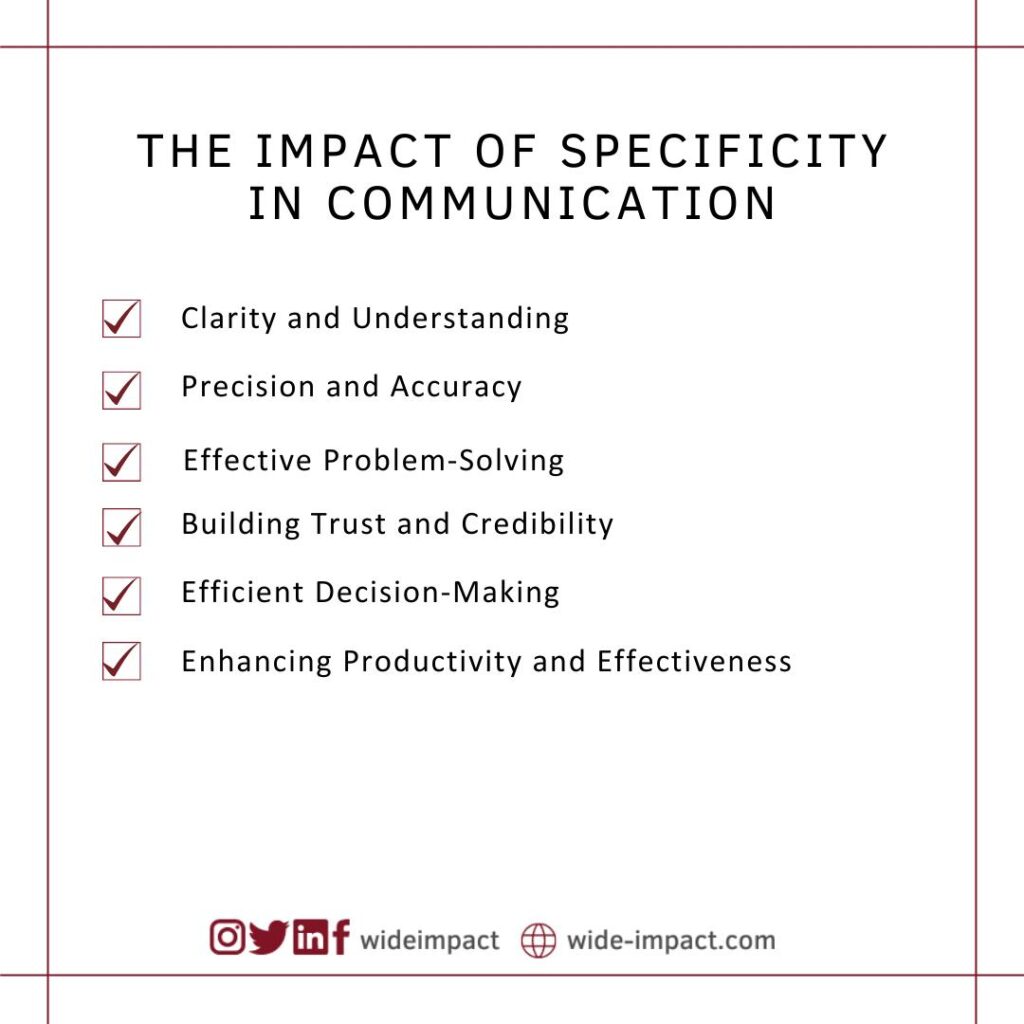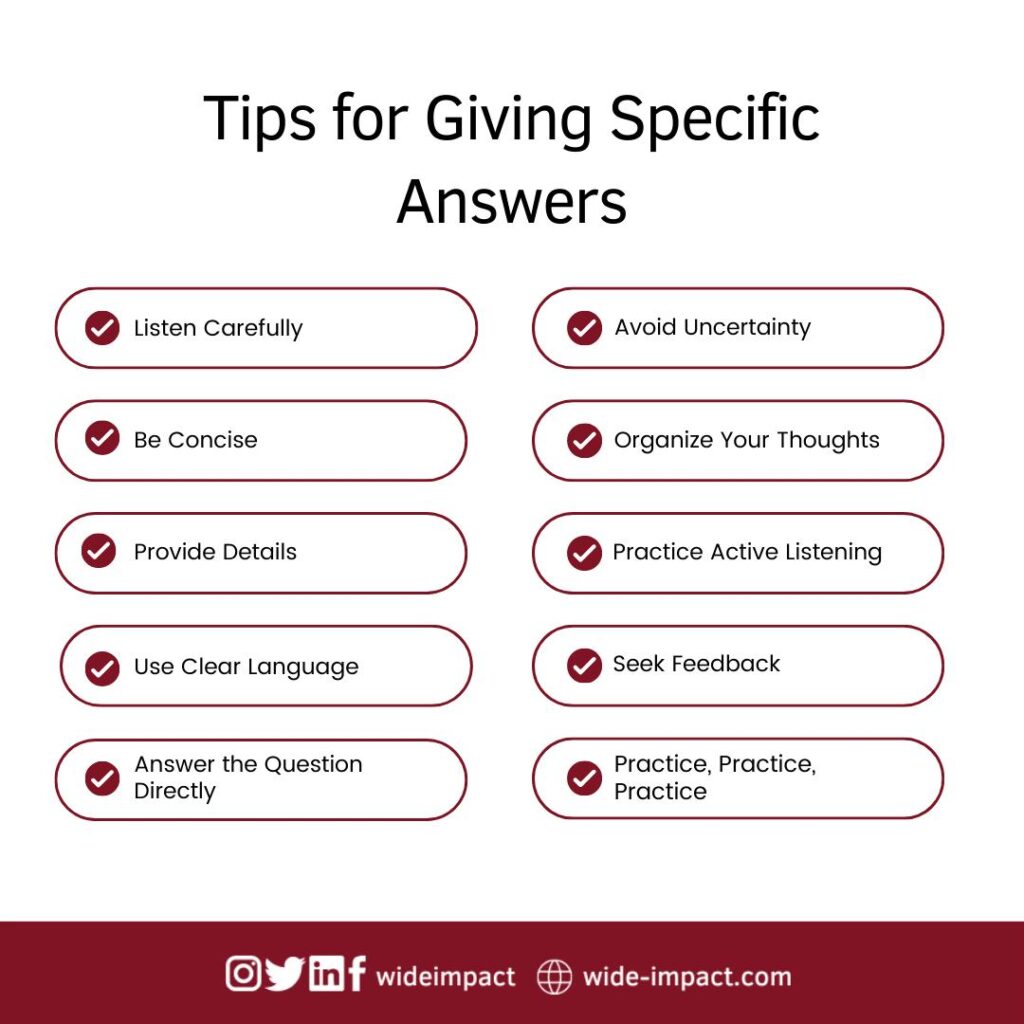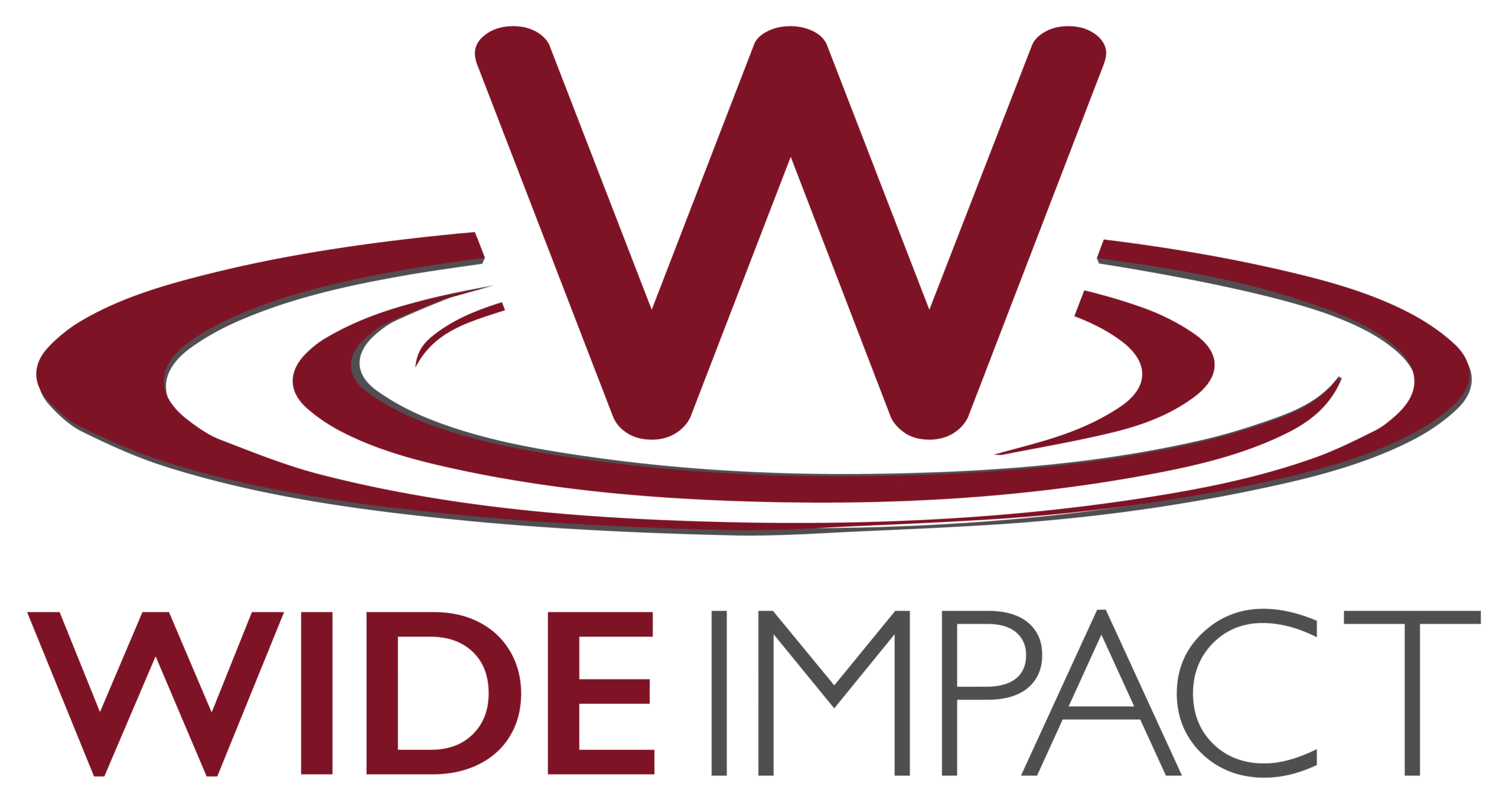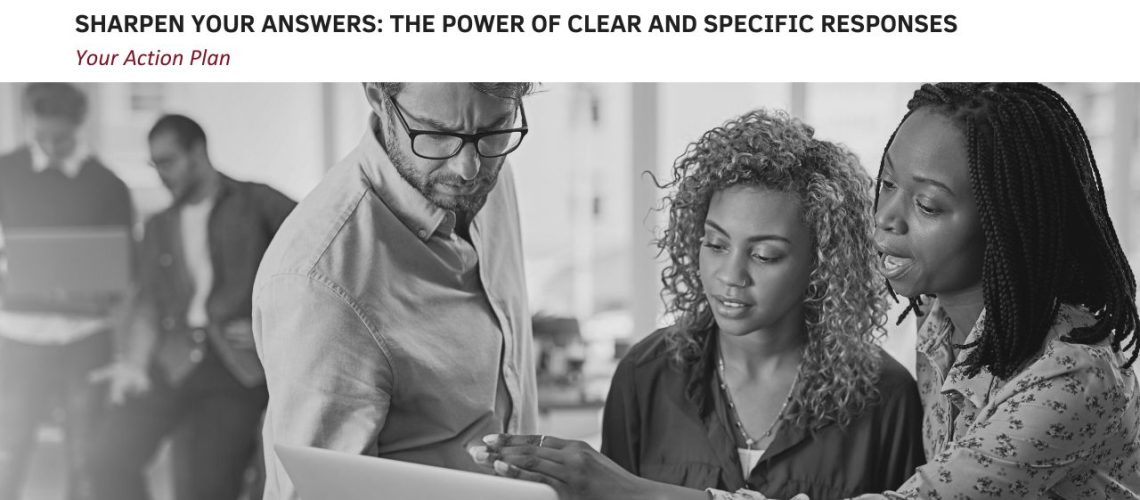By Dr. Salam Slim Saad
Have you ever found yourself in a conversation where the answers seemed to dance around the question, leaving you more confused than when you started? Effective communication is an art that requires precision and clarity to connect with others truly; it’s the cornerstone of success in every aspect of life, whether it’s personal relationships, professional interactions, or academic pursuits. At the heart of effective communication lies specificity – the ability to convey information accurately and precisely. Being specific in communication is essential for several reasons, each contributing to clearer understanding, enhanced relationships, and improved outcomes.
The Impact of Specificity in Communication
When it comes to communication, the way we respond can make all the difference.
Imagine you ask someone where they want to go for dinner. A specific response would be, “I’d love to try that new Italian restaurant downtown.” On the other hand, a vague reply might sound like, “Anywhere is fine with me.”
In a work setting, if you ask your colleague for a project update, a specific answer would include details like deadlines and progress made. In contrast, a vague response could be, “It’s in progress.”
Being specific helps avoid confusion and ensures everyone is on the same page. Take note of how your responses can impact clarity in various personal and professional situations.
- Clarity and Understanding: Specificity eliminates ambiguity and confusion, ensuring your message is conveyed clearly and accurately. Providing specific details, examples, and explanations leaves little room for misinterpretation or misunderstanding. Whether you’re giving instructions, sharing information, or expressing your thoughts and feelings, being specific allows others to grasp your message with greater clarity and understanding.
- Precision and Accuracy: Being specific enables you to communicate precisely and accurately, ensuring that your message is conveyed exactly as intended. Instead of using vague or general terms that can be open to interpretation, being specific allows you to convey precise details, facts, and figures. This precision enhances the credibility and reliability of your communication, making it more trustworthy and persuasive to your audience.

- Effective Problem-Solving: In problem-solving situations, being specific is essential for identifying and addressing issues efficiently and effectively. When discussing problems or challenges, specificity helps you pinpoint the root causes, analyze the relevant factors, and develop targeted solutions. By clearly articulating the specifics of the problem, you can collaborate more effectively with others to find viable solutions and overcome obstacles.
- Building Trust and Credibility: Specificity enhances your credibility and trustworthiness as a communicator. You instill confidence in your audience when you provide specific information, demonstrate attention to detail, and back up your statements with evidence or examples. People are likelier to trust and respect individuals who communicate with clarity, precision, and accuracy, fostering stronger relationships and deeper connections.
- Efficient Decision-Making: Being specific facilitates more informed and efficient choices in decision-making processes. By clearly defining goals, criteria, and priorities, you can evaluate options more effectively and confidently make decisions. Specificity enables you to weigh the pros and cons of different alternatives, assess potential risks and benefits, and ultimately choose the course of action that best aligns with your objectives.
- Enhancing Productivity and Effectiveness: Being specific enhances productivity and effectiveness by minimizing misunderstandings, reducing errors, and streamlining communication processes. When everyone involved in a task or project is clear about expectations, roles, and responsibilities, collaboration becomes smoother, and progress is accelerated. Specificity helps avoid unnecessary confusion, repetition, and wasted effort, allowing individuals and teams to focus their time and energy on achieving desired outcomes.
How Vague Responses Can Lead to Misunderstandings
Vague responses, characterized by uncertainty and lack of specificity, can create confusion, misunderstandings, and frustration in communication. Here are several ways in which vague responses can lead to misunderstandings:
- Lack of Clarity: Vague responses often lack clarity, leaving the recipient uncertain about the intended meaning. Without clear and specific information, it’s challenging for the recipient to understand the message accurately. This lack of clarity can lead to misinterpretation and confusion, as the recipient may fill in the gaps with their assumptions or interpretations.
- Miscommunication: Vague responses can result in miscommunication when the sender’s intended message is not effectively conveyed to the recipient. Without clear and specific details, the recipient may interpret the message differently from what the sender intended. As a result, the communication becomes ineffective, and the intended message may be lost or distorted in translation.
- Incomplete Information: Vague responses often fail to provide complete or sufficient information, leaving important details unspecified or unclear. This incomplete information can lead to misunderstandings, as the recipient may be left with unanswered questions or uncertainty about key aspects of the message. Without all the relevant information, the recipient may make incorrect assumptions or decisions based on incomplete data.
- Assumptions and Inferences: In the absence of clear information, recipients of vague responses may rely on assumptions and inferences to fill in the blanks. However, these assumptions and inferences may not align with the sender’s intended message, leading to misunderstandings and misinterpretations. Without clarification or confirmation from the sender, these incorrect assumptions can perpetuate misunderstandings and undermine effective communication.
- Frustration and Conflict: Continual exposure to vague responses can lead to frustration and conflict in communication. When recipients repeatedly encounter unclear or ambiguous messages, they may become frustrated with the lack of clarity and seek clarification from the sender. This can strain relationships and undermine trust, as recipients may perceive the sender as uncommunicative or unreliable.
- Impact on Decision-Making: Vague responses can hinder effective decision-making by providing insufficient or unclear information for informed choices. Without specific details or guidance, recipients may struggle to make decisions confidently, leading to delays or suboptimal outcomes. In professional settings, vague responses can impede progress on projects, hinder problem-solving efforts, and undermine organizational effectiveness.
Tips for Giving Specific Answers
Giving specific answers is crucial for effective communication and avoiding misunderstandings. Here are some tips to help you provide clear and specific responses:

- Listen Carefully: Ensure you fully understand the question or prompt before responding. Listen attentively to the speaker’s words, paying attention to both the content and context of the communication. If needed, ask clarifying questions to ensure you grasp the nuances of the inquiry.
- Be Concise: While providing sufficient detail is important, avoid unnecessary verbosity. Get to the point and focus on answering the question directly. Avoid rambling or going off on tangents, as this can dilute the clarity and specificity of your response.
- Provide Details: Offer specific details, examples, and evidence to support your answer. Concrete examples not only enhance understanding but also add credibility to your response. Whether you’re sharing personal experiences, citing data, or providing examples from relevant sources, be sure to offer specific details reinforcing your point.
- Use Clear Language: Choose your words carefully to ensure clarity and precision. Use plain language that is easy to understand, avoiding jargon, acronyms, or technical terms that may be unfamiliar to the recipient. Opt for clear, straightforward language that conveys your message effectively.
- Answer the Question Directly: Address the question or prompt directly, without deflecting or evading. Start your response with a clear and direct answer, then provide additional context or elaboration. Avoid beating around the bush or offering vague responses that fail to address the question at hand.
- Avoid Uncertainty: Be mindful of Uncertainty and strive to eliminate it from your responses. Avoid vague language such as “maybe,” “probably,” or “sometimes,” opting instead for specific terms and phrases that leave no room for interpretation. Clarify any terms or concepts that may be unclear to the recipient to ensure mutual understanding.
- Organize Your Thoughts: Structure your response logically and coherently to enhance clarity and comprehension. Organize your thoughts before speaking or writing, outlining the main points you want to convey and arranging them in a logical sequence. This will help you present your ideas in a clear and organized manner.
- Practice Active Listening: Actively listen to the speaker’s words, paying attention to both verbal and nonverbal cues. Take notes if necessary to help you remember key points and details. By actively engaging with the speaker and demonstrating attentiveness, you’ll be better equipped to provide specific and relevant answers.
- Seek Feedback: After providing your response, solicit feedback from the recipient to ensure clarity and understanding. Ask if they have any questions or if any areas require further clarification. Use their feedback to refine and improve your communication skills over time.
- Practice, Practice, Practice: Like any skill, giving specific answers requires practice and refinement. Take every opportunity to practice your communication skills in conversations, presentations, or written communication. With consistent practice and feedback, you’ll become more adept at providing clear and specific responses.
The art of being specific when answering questions is the key to unlocking greater clarity, understanding, and success in our personal and professional lives. By providing clear and precise answers, we can avoid misunderstandings, build trust, and foster stronger personal and professional relationships.
Remember, whenever you provide a specific and clear answer, you’re not just conveying information – you’re building bridges of understanding and fostering deeper connections.
So, challenge yourself to be specific in your response next time someone asks you a question or seeks your input. Your words have the power to shape perceptions, convey information effectively, and ultimately make a lasting impact on those around you. Choose precision over ambiguity, and watch how your communication skills soar to new heights.



